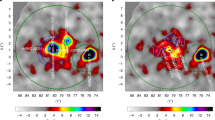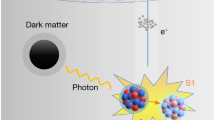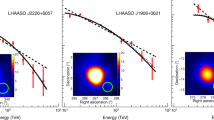Abstract
Two experimental groups1,2 working at different minimum energies have reported underground muons coming from the direction of Cygnus X-3 with rates that vary in synchrony with its binary period. The depths involved are such that the muons have energies of the order of 1 TeV for the shallower1 and several TeV for the deeper2 detector. Such observations, if verified, would require a new particle or a new physical process3. Here we explore our earlier suggestion4 that the new signal carrier could be a neutral bit of quark matter, condensed and stabilized by strange quarks. We also consider other, more general explanations and conclude that it is exceedingly difficult to find a self-consistent explanation of the observations.
This is a preview of subscription content, access via your institution
Access options
Subscribe to this journal
Receive 51 print issues and online access
$199.00 per year
only $3.90 per issue
Buy this article
- Purchase on Springer Link
- Instant access to full article PDF
Prices may be subject to local taxes which are calculated during checkout
Similar content being viewed by others
References
Marshak, M. L. et al. Phys. Rev. Lett. 54, 2079–2082 (1985).
Battistoni, G. et al. Phys. Lett. 155B, 465–467 (1985).
Watson, A. A. Nature 315, 454–455 (1985).
Barnhill, M. V. III, Gaisser, T. K., Stanev, T. & Halzen, F. MAD/PH/243/252 (1985).
Stanev, T. & Vankov, Ch. Phys. Lett. 158 B, 75–76 (1985).
Gaisser, T. K. & Stanev, T. Phys. Rev. Lett. 54, 2265–2268 (1985).
Liu, H. C. & Shaw, G. L. Phys. Rev. D30, 1137–1140 (1984).
Halzen, F. & Liu, H. C. Phys. Rev. D (in the press).
Farhi, E. & Jaffe, R. L. Phys. Rev. 30, 2379–2390 (1984).
Shaw, G. L., Benford, G. & Silverman, D. J. UC Irvine Tech. Rep. No. 85–14 (1985).
Witten, E. Phys. Rev. D30, 272–285 (1984).
Bjorken, J. D. & McLerran, L. D. Phys. Rev. D20, 2353–2360 (1979).
McLerran, L. D. et al. Pap. Conf. on New Particles, Madison (1985).
Neshpor, Yu. I. et al. Astrophys. Space Sci. 61, 349–355 (1979).
Danaher, S. et al. Nature 289, 568–569 (1981).
Lamb, R. C. et al. Nature 296, 543–544 (1981).
Samorski, M. & Stamm, W. Astrophys. J. Lett. 268, L17–L21 (1983).
Lloyd-Evans, J. et al. Nature 305, 784–787 (1983).
Elbert, J. W. Proc. DUMAND Summer Workshop, La Jolla, Vol. 2 (ed. Roberts, A.) 101–119 (Scripps Institution of Oceanography, La Jolla, 1979).
Gaisser, T. K. & Stanev, T. Nucl. Instrum. Meth. Phys. Res. A235, 183–192 (1985).
Author information
Authors and Affiliations
Rights and permissions
About this article
Cite this article
Barnhill, M., Gaisser, T., Stanev, T. et al. Constraints on cosmic-ray observation of Cygnus X-3. Nature 317, 409–411 (1985). https://doi.org/10.1038/317409a0
Received:
Accepted:
Issue Date:
DOI: https://doi.org/10.1038/317409a0
This article is cited by
-
Growing drops of strange matter
Nature (1989)
-
Sneutrinos from Cygnus X-3?
Zeitschrift f�r Physik C Particles and Fields (1986)
Comments
By submitting a comment you agree to abide by our Terms and Community Guidelines. If you find something abusive or that does not comply with our terms or guidelines please flag it as inappropriate.



